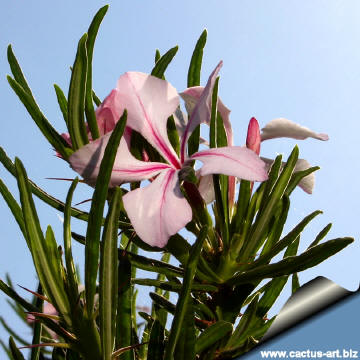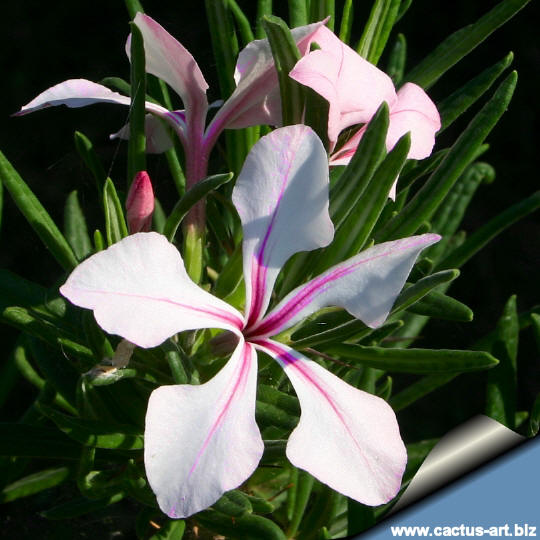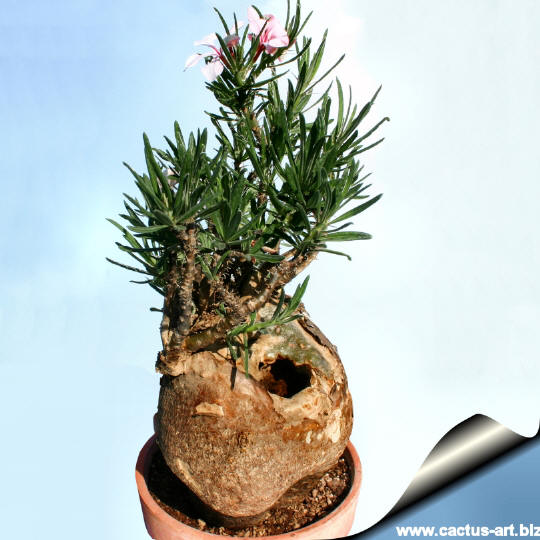|
|
|

Pachypodium succulentum is an unusual slow-growing caudiciform
succulent
and one the most floriferous of all pachypodiums species in cultivation.
|
 Description:
Pachypodium
succulentum
is a slow-growing caudiciform succulent shrublet with a large
half-submerged tuberous stem. Description:
Pachypodium
succulentum
is a slow-growing caudiciform succulent shrublet with a large
half-submerged tuberous stem.
Stem: The stem forms a basal turnip-shaped caudex up to 25 cm in
diameter that bears several twisting, usually erect slender branches
usually about 15-60 cm long and a few easy to avoid spines. The plant can grow
up to 1.5 and 2.5 metres of height.
Leaves: Linear with recurved margins, hairy on both surfaces up
to 45 mm long, less than 10 mm wide. they immediatelly distinguish this
species from the other broad leaved Pachypodiums, with the exception of
Pachypodium bispinosum. This species is not as deciduous than
most Pachypodiums, and will generally not lose all its leaves in winter.
Flowers: Crimson, pink, or (rarely) white, with a darker
midstripe which appears with the leaves.
The corolla tube is is 10-18 mm long with spreading petals 8-10 mm long
Blooming seson: August to December.
Seeds: It produces numerous seeds, although specialised
pollinators are required to produce a good seed set.
P. succulentum is a variable species which has been
described several times under different names now considered synonyms.
The early described P. griquense and P.
jasminiflorum are respectively the smallest flowered and the
white blooming forms. |
|
Culture: They seem to be particularly prone to rot if allowed to get
too wet in winter, or if cultivated under less
than ideal conditions and care. Water abundantly in summer and give
extra well-drained soil to avoid waterlogged conditions.
No water from November to March.
The watering program will change,
depending on temperatures and stage of growth, but it is best not to let
this plant dry out completely for any length of time. It
is sensitive to cold, and should be kept
totally dry in winter, at or around 4°C.
Protect from frost. It
tends to lose its leaves and go
dormant in winter. It likes
full sun to light shade . It
develops a great, succulent root system that you could raise up yearly
and it would look better and better.
Reproduction:
This species is easy to grow
from seed or cuttings.
It is easy to root from root
cuttings. A piece of root is removed, and immediately replanted, with
about 1 cm sticking out above the top dressing. Within a few days to a
few months, new leaves will start to form at the tip, shortly followed
by new branches and a new caudex. Stem cuttings can also be rooted,
though with more difficulty.
|
|

 |
|
Advertising
|
|
|
|
Family: Apocynaceae
subfamily: Apocynoideae tribe:
Malouetieae.
|
|
Scientific name:
Pachypodium succulentum
(L. f.) Sweet
Place of
publication: Hort. brit. ed. 2:594. 1830
Origin:
Origin: Endemic to South Africa.. It is estimated to have an extensive range (over 300,000 km2 ) and it is common or very common in
at least parts of its range.
Habitat: It is found
in arid places, usually among rocks associated with succulent scrub
vegetation at altitudes of 15-685 m . Unlike other South African species
of Pachypodium, P. succulentum is resistant to frost and sometime
withstand temperatures of -10° C in winter. It is naturally well adapted to the hot and
dry environment in which it grow. The succulent stems act as water
stores, and enable the plant to survive the harshest conditions. The
thick tuberous underground stem also help the plant to survive long
periods without water. It can therefore withstand intense heat and
long periods of drought.
P. succulentum can be confused with the sympatric
P. bispinosum when not flowering. In fact the spiny branches
of both sprout from a proportionally huge cauduciform taproot but
flowers and flowering times are different, and the two species do not
hybridize in habitat.
Conservation status: Listed in
CITES appendix 2.
|
Synonyms:
- Pachypodium
tuberosum
- Pachypodium
tomentosum
- Pachypodium
griquense
- Pachypodium
jasminiflorum
|
|
|

 |
|